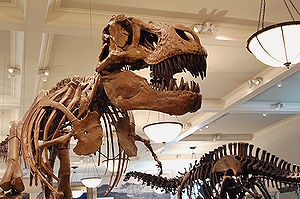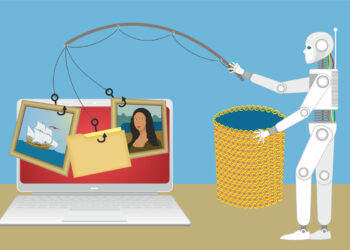
- Image via Wikipedia
It took a lunch discussion to make me aware of a blog post I missed. I was recently enjoying a talk with Silverchair‘s Thane Kerner and hashing over the predicaments of modern scholarly publishing when he started drawing graphs in the air and asked, “Didn’t you see my blog post?”
Sorry, missed it.
Well, here I am to make amends, because what Thane was talking about is important to the perceptual realm of creatures trying to avoid the fate of the dinosaurs. That’s right, folks — a meteor is approaching that epitomizes the environmental changes that will lead to the disappearance of the non-adapting dinosaurs, and this meteor is in the shape of an iPhone.
What we’re talking about is how purchasing patterns in the academy have irrevocably shifted from print to electronic resources.
Thane’s post (aptly entitled, “Quantifying the Obvious”) lays out data from the Association of Research Libraries and the Association of College and Research Libraries showing when the lines of expenditure crossed in multiple buying domains, some as long ago as 2006:

These data are compelling in and of themselves, but when you line them up with other data showing that the majority of revenues for STM publishers have been coming from electronic resources for the past few years, the equation is complete — print is no longer the dominant medium.
And there is no going back. We’re in the midst of a revolution of distribution, manufacturing, and information presentation and utilization. It’s a digital revolution. It’s a revolution that now dominates the purchasing and strategic frameworks for demand and supply.
If you, your editors, or your sales forces think otherwise, tell them to wake up and smell the gigabytes.
Most importantly, the days of undervaluing electronic may, quite properly, be coming to an end, as majority adoption logically leads to value shifts that will be reflected in pricing.
Discussion
2 Thoughts on "Academia and STM Publishing Have Gone Electronic"
No one who’s been paying any attention at all can disagree that digital resources have become more important than print. If one is to look at how digital content is valued, it’s worth looking at how value has been added to print, and considering how “being digital”[1] changes this.
The ways value is derived from digital content is quite different than that of a print version, despite them containing exactly the same characters, illustrations, and other content. I know this may sounds nonsensical at first to a traditional publisher, but it’s easy to see that this is the case if you shift your perspective and see things as “the people formerly known as the audience”[2] see them.
With print, one problem is that there’s a lot of material seeking to be published, and not a lot of space to fit it in. Editors add value by enforcing space and style constraints on submitted work, making it fit in a manageable size and be more easily comprehensible.
Another problem is one of discovery. How do you find the best and most relevant material? Journals add value by using their expertise and perspective to select truly important and valuable work to feature, so the reader doesn’t lose the important stuff in the sea of incremental updates and niche findings.
Another problem is that of delivery. Journals have invested in the infrastructure to format, print, and deliver their publications to libraries and labs across the world, and this adds value from a author’s perspective by reducing the upfront costs that would otherwise be required to get their work in the hands of thousands or millions of people.
Two out of three of the above ways journals have traditionally added value, from a consumer perspective, fail to add value to a digital resource. This is why the whole economic model has to change.
No longer is there limited space for digital content. Papers can be as long and contain as many illustrations and data tables as they need, for little added cost. However, while there’s nearly unlimited space, a reader’s time and attention remains limited. It follows, then, that a publisher can add value by personalizing the content to the reader. The reader, the former audience, has now become the searcher. They’re actively engaged and the place to engage with them is in their search. Discovery tools which show the searcher items related to the one they’re reading have worked fabulously for Pubmed. Social bookmarking services, such as the one I just linked to, base their entire business model on adding value in this way. Another service Mendeley actually uses the tagline “a last.fm for research”. Now that the former reader has become the searcher, they can be engaged via search and value can be added, in ways not even possible with print, by personalizing their search, guiding them to exactly what they’re looking for.
No longer is there much value added by distribution infrastructure. Yes, it costs quite a bit to host a journal website, but that’s not the number you should be looking at. The number you should be looking at is how much it would cost someone to write a search engine that indexed self-published manuscripts hosted in various repositories across the web. This isn’t a far off possibility, either. Duraspace has been out for some time now. There’s a growing trend of OA mandates. All that’s needed now is a good search engine to tie things together. That’s how much room you have to work with regarding costs of distribution, and it’s probably less than the costs you pay each year just in postage.
Thanks, David
1. A reference to the book Being Digital, by Nicholas Negroponte, which is now almost 15 years old, having come out while we were having these kinds of discussions about how digital content was changing the music idustry.
2. The phrase popularized by Jay Rosen, as part of the discussion on how digital media is changing non-academic publishing.
![Reblog this post [with Zemanta]](http://img.zemanta.com/reblog_e.png?x-id=17f5f010-3393-4d46-ae71-30e0b4801234)


